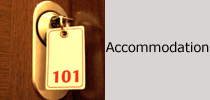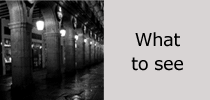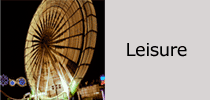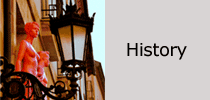
|

|

|

|

|

|

|

|

|
Itinerarios posibles
Here are some possible itineraries to see and visit the monuments and museums in Salamanca:
- Salamanca in one day
- From the Plaza Mayor to the cathedrals
- A tour of the universities
- From the Compañía street until the Fonseca school
- From San Esteban to the river
Salamanca in one day
An itinerary that starts and ends at the Plaza Mayor.
Salamanca is special city, which is difficult to visit in one day because it is full of cultural things to see. The hurried traveler won’t have time to see all the historical and artistic buildings of this beautiful city. Also in the city of Tormes there is a free, dynamic and cosmopolitan spirit thanks to the prestigious university, a spirit that is impossible to avoid when you walk around, especially on the Rúa Mayor or the Plaza Mayor.
The entire historic centre, declared World Heritage by UNESCO, is pedestrianised where you can take a relaxed and rewarding walk.
It consists of the following stops:
-
o Plaza Mayor
o Casa de las Conchas
o Puente Romano
o Huerto de Calixto y Melibea (monumento a La Celestina)
o Rúa Mayor
o Convento de las Dueñas
o Torre de Clavero
o Plaza Mayor
During this itinerary there are two museums that you can visit:
-
o Museo Art Nouveau y Art Déco - Casa Lis.
o Museo de la Historia de la Automoción - Plaza del Mercado Viejo.
After this tour of Salamanca it is advisable to take a little break and, depending on your tastes and the season, take a seat in one of the terraces or in a cafe. If you choose the second option and you could retire to some of the marble pedestal tables in the Novelty Coffee cafe and be near to two of the greatest writers linked to the history of the city: Miguel de Unamuno and Gonzalo Torrente Ballester.

From the Plaza Mayor to the cathedrals
To find the true heart of Salamanca you need to go to the Plaza Mayor and a good place to start to reach the two cathedrals of the city. The Old Cathedral is in Romanesque style and the New Cathedral, in Gothic style, which was built in the early sixteenth because the original was too small. On the way to the plaza del Corrillo y de la Rúa Mayor you can visit places like the iglesia románica de San Martín and the emblematic Casa de las Conchas.
It consists of the following stops:
-
o Plaza Mayor
o Plaza del Corrillo – Iglesia de San Martín
o Rúa Mayor
o Casa de las Conchas
o Plaza Anaya
o Patio Chico
o Catedral Vieja
o Catedral Nueva
The Plaza Mayor in Salamanca is one of the most beautiful plazas with the most personality in Europe. Work began on the plaza in 1729, following the baroque style; it was designed by renowned architect Alberto de Churriguera. The monument was built entirely with the golden stone of Villamayor. In 1755, Andrés García de Quiñones closed its perimeter with the Town Hall.
The cathedrals of Salamanca offer all of its visitors a unique experience. You
can almost touch the sky from the top of its medieval towers, a privilege that until recently was reserved for a select few an is only possible in a few cathedrals in Europe. This idea began with an exhibition on the French Bishop Jerome Périguenaux, star of the final repopulation of the city and primarily responsible for the construction of the first Romanesque cathedral. The exhibition, entitled Ieronimus comprises documents, books, hymnals, drawings, models and various objects related to the long construction process which lasted round nine hundred years, the two cathedrals of Salamanca.

A tour of the universities
The University of Salamanca, as well as marking the demographic, historical and cultural evolution of the city, the academic institution definitively contributed to the shaping of its monuments. The university buildings are concentrated in a small urban space, centred around the courtyard of the schools, which hold the title "city of knowledge". The university tour goes by el paseo Anaya, las Escuelas Mayores, el Hospital del Estudio, las Escuelas Menores y la Casa Rectoral with Unamuno’s museum and fnishes with the Museum of Salamanca, la Casa Lis, la Cueva de Salamanca y el huerto de Calixto y Melibea.
: It consists of the following stops:
-
o Colegio Anaya
o Universidad
o Patio de las Escuelas
o Escuela de Menores
o Calle de Libreros
o Casa Lis
o Huerto de Calixto y Melibea

From the Compañía street until the Fonseca school
Salamanca is not only the Plaza Mayor, two cathedrals and the university, but also a series of palaces, mansions, convents, churches and colleges located throughout the city. The highest concentration of monuments is in near calle de la Compañía and the surrounding squares: St. Benedict, las Augustinas, Monterrey and las Úrsulas. From the Plaza Mayor the walk takes you to la Clerecía and continues to calle Compañía until palacio de Monterrey and then, for a change of course, the trip finishes with el colegio mayor Fonseca. On the way to these places there are many artistic places worth stopping to look at.
It consists of the following stops:
-
o Iglesia de la Clerecía
o Iglesia de San Benito
o Palacio Monterrey (Plaza de las Agustinas)
o Iglesia de Santa María de los Caballeros
o Convento de las Úrsulas
o Colegio del arzobispo Fonseca

From San Esteban to the river
This walk starts from the Plaza Mayor, through the el arco del Ochavo and by the calle de San Pablo, where eventually you come to the conventos dominicos de las Dueñas y San Esteban. Then, on the way to the banks of the river Tormes, you can see a number of monuments, including the palacios de la Salina y Orellana y las torres del Clavero y Abrantes. The final leg of the journey, you will discover the recovered river banks the automotive Museum, the two churches under the invocation of apóstol Santiago. Finally, you will reach the Roman bridge.
It consists of the following stops:
-
o El palacio de la Salina
o La Torre del Calvero
o Plaza de Colón
o Convento de San Esteban
o Las Dueñas
o Museo de la Automoción
o Iglesia de Santiago
o Puente Romano















 info@ciudaddesalamanca.es
info@ciudaddesalamanca.es